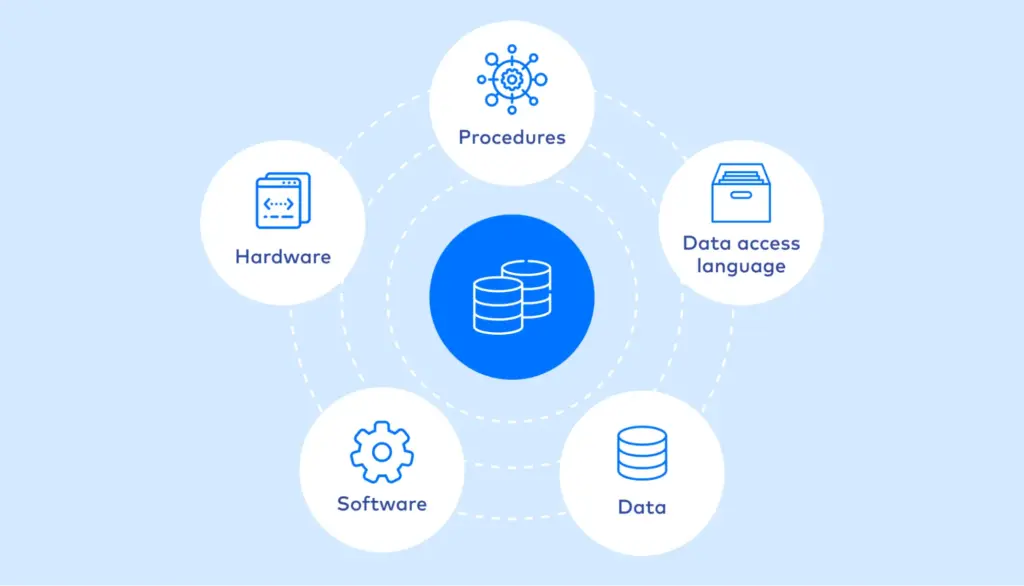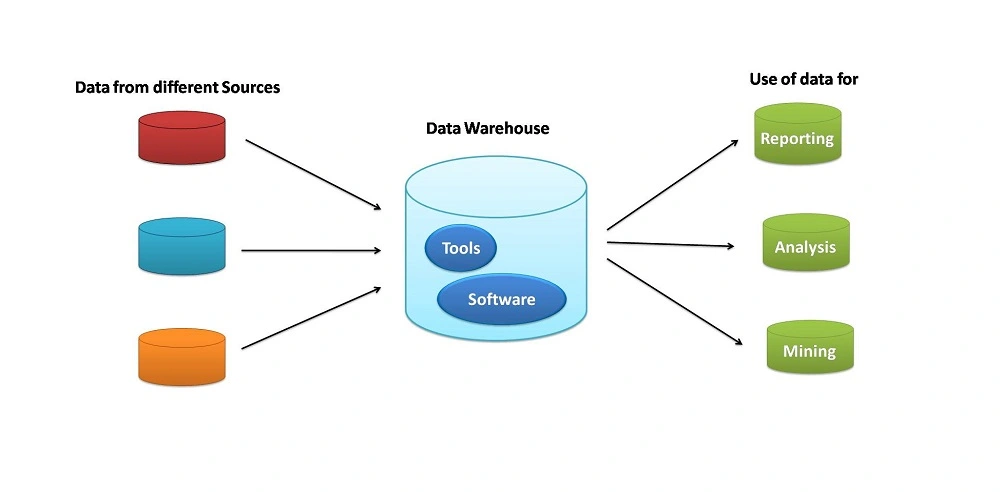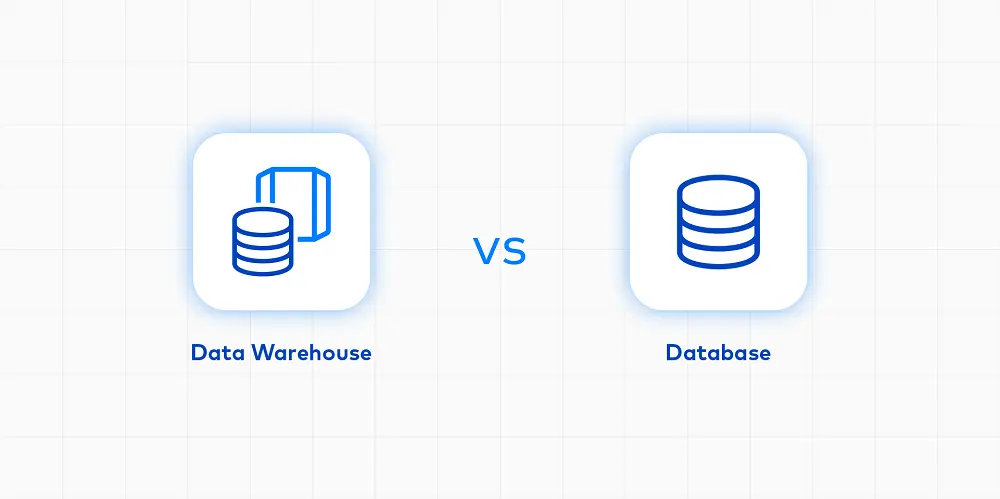What is a database?
Database is an organized collection of facts or information that can be changed and retrieved. The key task of the database is to perform query processing.
This system is generally referred to as an online transaction processing system (OLTP). It is used in day-to-day operations of an organization. Database is also a part of your data solution, thus it is really important.

What is a data warehouse?
Data Warehouse is where structured data acquired from many sources is stored for analysis and reporting. Because business decisions are based on data consolidation, analysis, and a variety of reporting, a data warehouse is critical to the process of making them.
According to the decision-making system, data warehouses take vast amounts of heterogeneous data, then translate it into analytic reports before storing it.

For instance, a business can store a variety of its employees’ information such as their names, addresses, salaries, and job descriptions, as well as information about the items and services it sells and the money it makes. There may be a need for data on sales growth and personnel performance to be sent to the top management.
All of the data in the data warehouse will be examined using a decision-making system to obtain this information. A data warehouse serves this primary function. Future decision making can be aided by the utilization of the data warehouse.
Similarity between database and data warehouse
Data is stored in both a database and a data warehouse. Storage systems are what you’re looking at. Typically, the bottom tier of a data warehouse is a relational database. Relational database systems are also databases, with data stored in rows and columns in relational database systems.
Both database and data warehouse let multiple users access the same data at the same time. Many users can simultaneously access a single database or data warehouse. To get at the data, you’ll need to run queries in both the datawarehouse and the database. Complex queries can be used to access the data warehouse, but simple queries can be used to access the OLTP database. And finally, whether on-premises or in the cloud, a company’s data warehouse and database are available.
10+ differences between database and data warehouse

Before we get into database vs data warehouse, we will explain to you about two processing methods: Online Transaction Processing (OLTP) and Online Analytical Processing (OLAP). Here are the definitions of these two:
- Online transaction processing (OLTP): Online Transaction Processing or OLTP refers to a class of systems capable of supporting transaction-oriented applications such as online banking, shopping, order entry or sending text messages.
- Online analytical processing (OLAP): As we got transaction data from OLTP, enterprises would then utilise Online Analytical Processing to extract insights and make more informed decisions. Hence, Online Analytical Processing can be defined as a computing method that allows users to easily generate and query data for analytical purposes.
How is data warehouse different from database? Is data warehouse a database? let’s take a look at this table:
Data Warehouse Vs Database Comparison Table
| Database | Data warehouse | |
|---|---|---|
| Definition | Database is an organized collection of data that is saved, modified, and returned to users in accordance with the users’ specifications. | Data warehouse is a data management system to unify data from multiple sources for analysis and reporting purposes. |
| Main purpose | Record data | Analyze data |
| Design | When updating real-time data, database is most concerned with accuracy. | Data warehouse ensures that a wide variety of data can be accessed over time for the purpose of analysis. |
| Processing method | OLTP | OLAP |
| Orientation | Application oriented | Subject oriented |
| Focus | Transactions are the primary focus of database queries. | A data warehouse’s primary function is to collect and analyze data from a variety of sources and provide reports. |
| Data Type | Database comes in all shapes and sizes. OLTP, CSV, text files, Excel spreadsheets, and XML files. The data is real-time and up-to-date. | Data warehouse sits atop other databases and are used for analysis. Data warehouse stores current and historical data. |
| Storage limit | Store data from a single application | Store data from multiple applications |
| Data designing technique | ER modeling techniques | Data modeling |
| Optimization | Single-point-transaction (SPT) database is optimized for read-write operations. Nearly all of the time, OLTP database queries are answered instantly. | In order to handle broad analytical queries, data warehouses are geared for retrieving big data sets and aggregating the data. |
| Reporting | Database uses a less dynamic reporting style. In most cases, these are one-time lists. It is possible to save these results in the form of PDFs. It’s possible to mix data from multiple tables, and complicated queries may be required. | With a data warehouse, if you want to know how a business is doing, you can’t just use a static report. The data is gathered and summarized into various reports for analysis. |
| Data Duplication | Normalized data. Table and joins are complicated. Normalized data is used in an OLTP database to improve processing and efficiency, and there is no duplication of data with a database. | Denormalized data. Table and joins are simple. With a data warehouse, the data is structured in an OLAP database in such a way that analysis and reporting are made easier. There are usually fewer tables in a basic structure since the data is denormalized. |
| Data availability | Data in database is available in real-time | Data is refreshed from source systems |
| Data schema | Data is structured in a flat relational approach method. Physical – Logical schema. | Data is structured in dimensional and denormalized approach method. Star – Snowflake schema. |
| Uptime | 99.99% uptime | Downtime is built-in to for uploading new data |
| Query | Simple transaction queries | Complex queries |
| Concurrent users | Only one user can modify data at a time | Serveral users can modify data at the same time |
| Data summary | Detailed data | Summarized data |
| Use case – Banking | Database stores customer information, account-related activities, payments, deposits, loans, credit cards… | Data warehouse manages the resources available on the desk. |
| Use case – Airlines | Database stores reservations and schedule information. | Data warehouse is used for airline system management operations, such as crew assignment, analyzes of route, frequent flyer program discount schemes for passenger… |
| Use case – Telecommunication | Database stores call records, monthly bills, balance maintenance… | Data warehouse is used for making product promotions, sales decisions, and distribution decisions. |
| Disadvantages | High budget due to hardware and software cost. Can not perform complicated queries. May lose control over the data.(privacy, ownership, security issues). | Highly complex for end-users. Require training or hire expert for setting up. High maintenance. Extracting, loading, and cleaning data is time-consuming. May have problems that are undetected for years. |
In case you do not exactly understand what is going on and how to choose the most suitable one for your business, we got you covered! Synodus Data Analytics Services provides you with a wide range of expertise, technologies and consultation. Our seasoned experts could lend you a hand and check up on your business to determine and consult you about which way is the best to build your own schema.
Conclusion
When it comes to data management & monetization, database and data warehouse both play a crucial part in recording and analyzing data for your business. While database aids in day-to-day business operations, data warehouse helps you to analyze your business. Hence, based on your specific business goals, you can choose either one of them.
Data warehouse vs database: We may sum it up by saying that although the database aids in day-to-day business operations, the data warehouse aids in the analysis of that business. Based on your company’s objectives, you can select between the two.
More related posts from Big Data blog you shouldn’t skip:
- How You Can Use Data Analytics for Better Inventory Management
- Data Analytics for SMEs: What You Should Know
- 9 Representative Retail Data Analytics Use Cases & Examples
How useful was this post?
Click on a star to rate it!
Average rating / 5. Vote count:
No votes so far! Be the first to rate this post.




